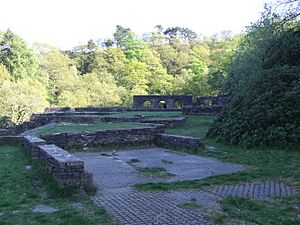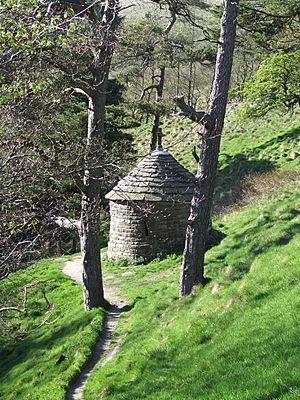Errwood Hall facts for kids
Quick facts for kids Errwood Hall |
|
|---|---|
 |
|
| OS grid reference | SK008747 |
| District |
|
| Shire county | |
| Region | |
| Country | England |
| Sovereign state | United Kingdom |
| Police | Derbyshire |
| Fire | Derbyshire |
| Ambulance | East Midlands |
| EU Parliament | East Midlands |
The ruin of Errwood Hall is a popular place to visit in the beautiful Upper Goyt Valley. This valley is part of the Peak District National Park in England.
Contents
The Story of Errwood Hall
Errwood Hall was built in the 1830s. A rich businessman from Manchester named Samuel Grimshawe had it built. His family, the Grimshawes, lived in the hall for about 100 years.
A Busy Estate
Errwood Hall was the center of a very large estate. An estate is a big area of land with a main house. This one was over 2,000 km2 (about 5,000 acres) in size! It included several farms and even a school. There was also a local pub called the Cat and Fiddle Inn. The family even had their own private coal mine. A small village called Goyt's Bridge was also part of the estate. The Grimshawe family planted many special trees. They especially loved rhododendrons and azaleas.
Why the Hall is a Ruin Today
Samuel Grimshawe's grandchildren were the last family members to live at Errwood Hall. The hall was later taken down in 1934. This happened because a new water supply was being built. The Fernilee Reservoir was under construction nearby. Stones from the old hall were used to help build the water treatment works. These works clean the water below the reservoir.
Errwood Hall and the Estate Now
Today, only the foundations of Errwood Hall remain. You can see the outlines of the ground floor. A few parts of the walls are still standing. These ruins are now looked after by the Peak Park Authority. They make sure the ruins are safe and preserved.
The Family Graveyard
On a hill a short walk west of the hall ruins, you can find the family graveyard. This graveyard was fixed up in the 1980s. It is where some members of the Grimshawe family are buried.
The Spanish Shrine
North of the hall, there is a small shrine or chapel. The Grimshawe family built it to remember someone special. This was Miss Dolores de Ybarguen. She was a Spanish noblewoman. Miss Dolores was the teacher at the estate school. She also worked as a governess for the Grimshawe children. She passed away while visiting Lourdes in France. People still visit the shrine today for quiet prayer and to remember loved ones.
The Rhododendrons and Reservoirs
The rhododendrons planted by the Grimshawes have grown a lot! They are now carefully managed to keep them from spreading too much.
Much of the old estate, including the village of Goyt's Bridge, is now under water. This is because of the Errwood Reservoir. However, the old packhorse bridge from Goyt's Bridge was moved. It was rebuilt further up the valley.
The area around Errwood Hall is very popular. Many people visit this part of the Peak National Park. It's a great place to start many walks in the upper Goyt Valley.





